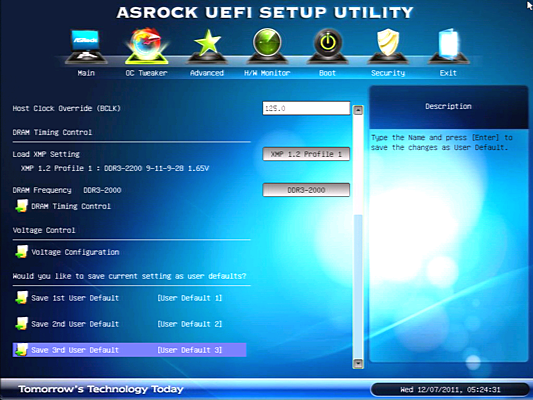Ultimate X79? Five $320+ LGA 2011 Motherboards, Reviewed
Our flagship motherboard comparison announcement was answered with an interesting selection of models, along with a bunch of “not ready yet” responses. Today we examine a few samples from companies bold enough to step up to the plate during launch week.
X79 Extreme9 Firmware
Early on, we figured out why so many of ASRock’s competitors were unwilling to send a sample this soon. Most companies spent months developing firmware for Intel’s C0-stepping pre-production processors, only to uncover overclocking issues after installing the retail C1 versions of the same model CPU.
We've heard that changes in thermal and possibly current protection have made Intel's C1 processors more difficult to overclock, and have even seen some of this in the particularly bad sample delivered to us by Intel. Even at a moderate 1.35 V core and modest sub-60° (Celsius) temperature, the processor did not want to go past 4.4 GHz. The Extreme9 made tuning even more difficult by not rebooting when set to any multiplier beyond those supported by the Core i7-3960X' stock Intel Turbo Boost scheme.
Ed.: Prior to this story going live, I took an ASRock X79 Extreme4-M motherboard and updated it to firmware version 1.4, which makes an update to the board's CPU code. Dialing in a 4.3 GHz overclock, just as a test, was as easy as picking a 43x CPU multiplier. It seems that the same overclocking issue affecting the X79 Extreme9 might have already been fixed on some of ASRock's other platforms.
Further complicating matters was that we did not find any explicit boot strap controls. This was something we discussed with ASRock prior to this piece, but it wasn't until after it went live that we learned this feature operates automatically. Jumping straight to a 125 MHz base clock normalizes the PCI Express and DMI buses. The same goes for 166 MHz. It turns out that the boards are set to increase boot strap automatically to 125 MHz when BCLK is set beyond 112 MHz, and to 166 MHz when BCLK is set to 150 MHz. Now that we've documented it, ASRock promises to as well.
ASRock does offer a good selection of power and ratio controls that lay the foundation for future firmware improvements however, and it even equips the board with dual EPS12V connectors to handle the extra load. We could have given up and used the C0-stepping CPU that we know works very well, but that wouldn't have made any sense because it’s not available for purchase. We instead were forced to start with a 125 MHz BCLK and work with lower CPU multipliers to achieve our final overclocking results.
A full set of voltage controls help users to push the limits of their processors. We found that Load-Line Calibration level 4 kept our voltage consistent, while lower-numbered settings forced higher-than-set voltages under load.


Primary and secondary timings can be keyed in directly, eliminating the former annoyance of having to dial in manual mode first.
Get Tom's Hardware's best news and in-depth reviews, straight to your inbox.
-
lradunovic77 Something is wrong with your ASRock Extreme 9 testing. You article states that you used BIOS 1.40 however first release for this Motherboard was 1.60 and they also recently released 1.70. Bios 1.40 is for ASRock Extreme 4 which i own as well. Again in mean time they updated BIOS for ASRock Extreme 4 to version 1.50 which greatly improves overclocking. I have C1 and i am hitting 4.4Ghz easily. (1.50 BIOS ASRock Extreme 4).Reply
You might want re check the facts.
Thanks. -
Crashman lradunovic77Something is wrong ...You might want re check the facts.Please do verify the facts beginning with the first X79 Extreme9 UEFI screenshot on page 3, showing version P 1.40 . The latest public firmware was downloaded for every motherboard on November 18, which is before ASRock says its P1.60 was even published. And, if you check Newegg, you'll find that Newegg was actually selling the X79 Extreme9 before firmware P1.60 was published.Reply
How could that happen? ASRock has repeatedly removed previous BIOS versions from its website and labeled the replacement as the initial release.
This review was published after many hours of collaboration with ASRock, and some of the problems with this specific CPU are further detailed in the overclocking section. ASRock acknowledged the problem exists with a portion of the C1 CPU supply and has begun issuing patched BIOS to fix the multiplier issue, according to ASRock engineer William Yu. -
oxxfatelostxxo ReplyI have C1 and i am hitting 4.4Ghz easily. (1.50 BIOS ASRock Extreme 4).
Not to mention that they didnt say they couldnt hit 4.4ghz, they just stated they didnt get that high without going beyond 1.35v
Kinda wish we got to see a MAX overclock for air before temps got out of control =P
But then you get various coolers involved... yada yada... but PLEASE anyway -
clonazepam This was a fun article to read. I wanted to quote a few bits here and there just to point out I enjoyed the humor in it, but that would have been a lot of quotes. It's subtle, tasteful way to add personality to the piece.Reply
I had to comment on something. I can't really comment on the hardware as its so enthusiast and SB-E is well beyond my needs. I can't comment too much on the bios because I still barely understand mine, but I am seeing the trend that it might be best to stick with what you know, or risk having to translate the various names/definitions of settings across different products. I'm not that smart nor that patient. I liked the comment on the 6.00...lol... %! I never would have thought. I think that just deciphered half of my bios options, thanks. /wink -
In the comparison table on the ASUS : "6 (x16/x0/x4/x16/x4/x0 or x8/x8/x4/x8/x84/x8)" -- x84 seems somewhat unlikely ;-)Reply
-
gmcizzle Not surprised both Asus boards came out on top performance wise, on most of these mobo roundups they usually do.Reply -
Steveymoo Without trying to sound critical, wouldn't it be prudent to test SLI scaling on these enthusiast boards? 1, 2, and 3 way SLI, extra PCI-E bandwidth is one of the main reason why people even bother splashing out the extra cash on these chipsets. (Aside from the extra epeen++)Reply
Just sayin' -
Crashman shstoneIn the comparison table on the ASUS : "6 (x16/x0/x4/x16/x4/x0 or x8/x8/x4/x8/x84/x8)" -- x84 seems somewhat unlikely ;-)Thanks. Yes, the x4 stays the same. Fixed!SteveymooWithout trying to sound critical, wouldn't it be prudent to test SLI scaling on these enthusiast boards? 1, 2, and 3 way SLI, extra PCI-E bandwidth is one of the main reason why people even bother splashing out the extra cash on these chipsets. (Aside from the extra epeen++)Just sayin'You obviously don't understand the value of those +++'s!Reply -
AstroTC AsRock has the better looking MB by far...Reply
Question does tht little fan on the motherboard get loud? If it does that would be a deal breaker for me -
CaedenV the problem with testing mobos is that they all have the same core (in this case the x79) which is what determines the raw speed of the system and busses, so they are all pretty well bunched together with no possibility of seeing any real world difference between boards. The things that differentiate the boards is in their feature sets, and as they are all rather different there is no proper way to test them against one another. Add to that the fact that these are all brand new boards which will see improvements with new UEFI releases, and there is really no way to pick a clear winner.Reply
On a side note I would love to see how these boards look assembled :)




